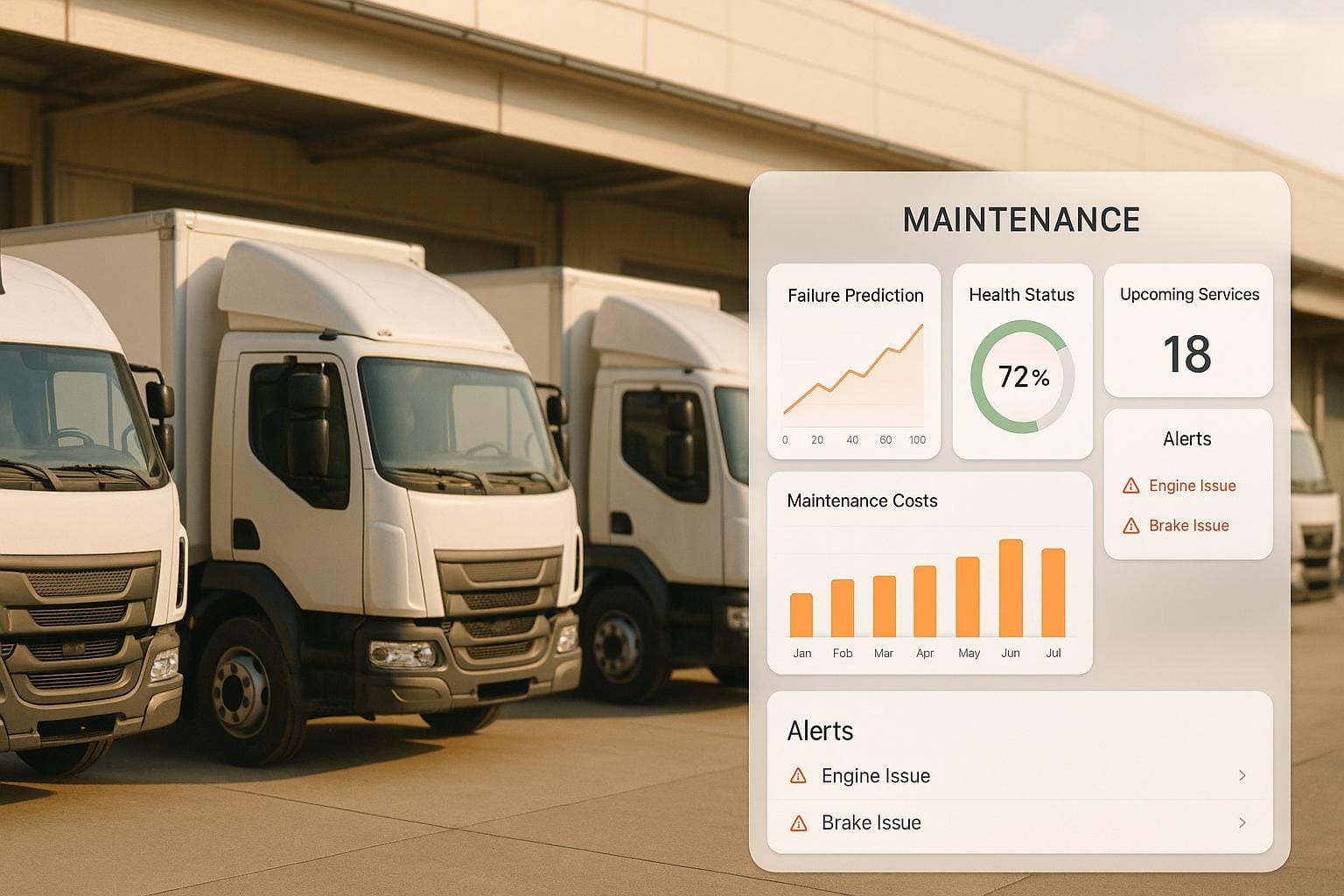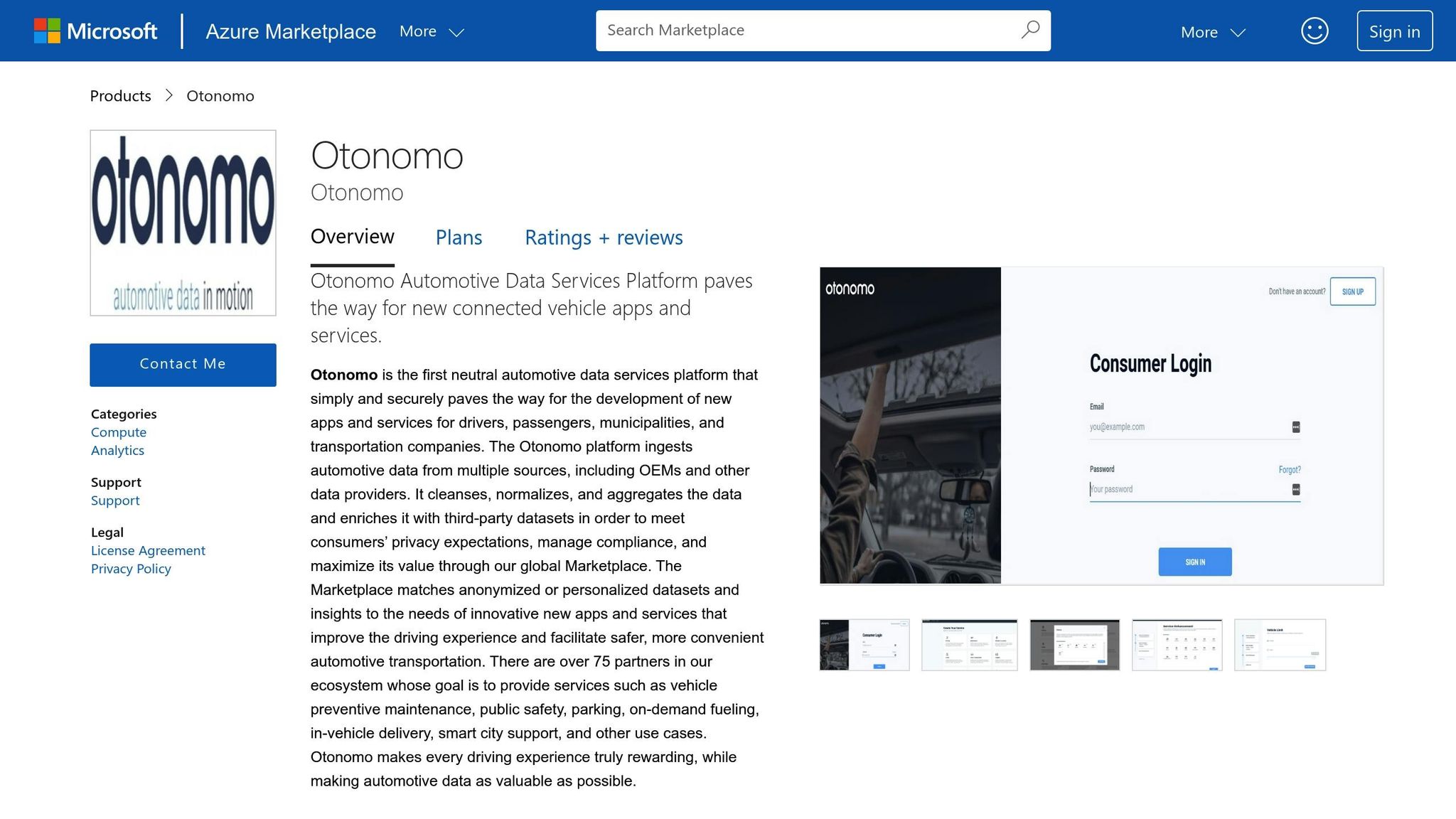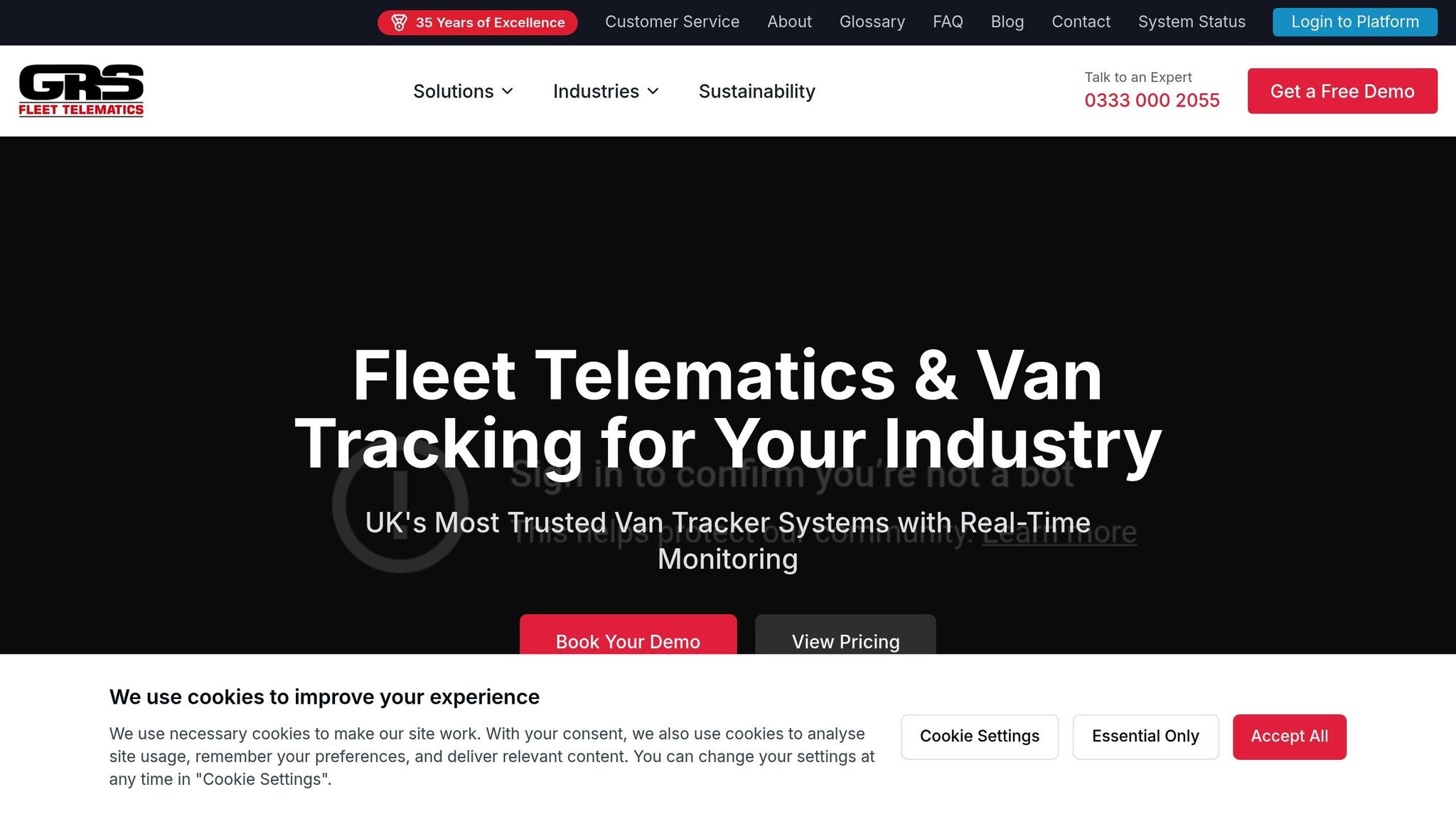API Data for Predictive Maintenance in Fleets
Explore how API-driven predictive maintenance enhances fleet operations by reducing costs, improving safety, and utilising real-time data insights.

Fleet maintenance is evolving, and API-driven predictive maintenance is leading the charge. By using real-time data from vehicle sensors, fleet operators can predict when maintenance is needed, reducing costs and preventing unexpected breakdowns. This approach shifts away from fixed schedules or waiting for failures, instead focusing on vehicle-specific insights to optimise repairs.
Key Benefits:
- Cost Savings: Maintenance costs can drop by up to 25%, and vehicle availability can increase by 20%.
- Improved Safety: Early detection of faults reduces risks and extends vehicle lifespan.
- Efficiency Gains: Real-time alerts and historical data analysis streamline maintenance decisions.
How It Works:
- Data Collection: Sensors track engine performance, brake wear, tyre pressure, and more.
- API Integration: Data flows to fleet management platforms for analysis.
- Actionable Insights: Alerts flag potential issues, enabling timely repairs.
While challenges like data quality, integration complexity, and cybersecurity exist, solutions such as robust data validation and secure API connections can address these. Predictive maintenance is transforming fleet operations, making them smarter and more reliable.
Streamlining Fleet Operations with the Otonomo Platform: From Preventive to Predictive Maintenance.

API Data Sources for Vehicle Health Diagnostics
Modern fleet vehicles produce a wealth of data from various sources, offering a comprehensive view of vehicle health that API systems can analyse and interpret effectively.
Types of API Data Used in Predictive Maintenance
Different types of data play a key role in identifying faults early and ensuring timely maintenance. For instance, telematics data - such as GPS coordinates, speed, and vehicle status - provides a continuous stream of information to cloud platforms, delivering a real-time snapshot of fleet operations.
OBD-II readings go a step further by monitoring Diagnostic Trouble Codes (DTCs) and engine metrics like RPM and coolant temperature. Emission data, on the other hand, ensures vehicles meet environmental regulations.
Sensor data adds another layer of precision. For example, tyre pressure monitoring systems can flag potential safety risks or fuel inefficiencies. Similarly, battery and fuel system indicators help predict component failures, while brake system monitoring ensures safety-critical parts remain in working order.
To round out these insights, historical maintenance records provide context for current data, helping algorithms identify normal wear-and-tear patterns and anticipate when components may need attention based on past performance.
All these data types are systematically gathered and integrated for analysis, creating a unified picture of vehicle health.
Data Collection, Transmission, and Integration
The process of turning raw vehicle data into actionable insights involves several key steps. Telematics devices collect information from systems like GPS and engine diagnostics. This data is then sent to cloud-based platforms, where it undergoes processing and analysis.
Fleet APIs act as the glue that connects various software systems, consolidating data from tools and third-party platforms into a single, real-time dashboard. This integration eliminates the traditional silos in fleet management, where GPS data, maintenance logs, and fuel usage information often existed in isolation.
Automating these integrations not only reduces manual errors but also eases administrative workloads. Tim Hill, CEO of Fleetyr, highlights the risks of manual processes:
"Segmented, you can't get as much insights out of [your data] as you would like, and there's the opportunity for manual manipulation before it gets to you... And there's also the chance that everyone makes mistakes. Humans make mistakes."
Data flows from sources like telematics, GPS trackers, maintenance systems, fuel usage monitors, and driver behaviour analyses. Cloud platforms then process and integrate this diverse data into a cohesive view of fleet operations.
To achieve this, standardisation, security, and compatibility are essential.
Requirements for Effective API Integration
For APIs to function seamlessly, several technical and operational factors must be addressed. Data standardisation is key, as it ensures consistent processing of information from different vehicle makes and models. Without this, comparing performance across a mixed fleet becomes challenging.
Secure connectivity is equally important, especially given the sensitive nature of fleet data. Providers must safeguard data integrity and prevent breaches by employing measures like HTTPS encryption during transmission.
System compatibility is another critical factor. New API integrations must work smoothly with existing fleet management systems. A good example is ArcBest, which used Samsara's open API to integrate with their proprietary compliance software, streamlining workflows.
Modern fleet operations rely on robust API integrations to connect various systems. However, this complexity requires careful planning and regular upkeep.
Tim Hill also underscores the importance of data ownership when working with APIs:
"When you're first choosing software, a big thing is to ask them, 'How do I get my data out of here?' If they say, no, it's their data, then walk away. It is your data. It should always be your data because you are the ones creating it out of any of these systems."
For successful API integration, thorough testing, secure authentication, and regular monitoring are essential. Fleet managers must also ensure consistent data input and maintain connections, as outdated APIs can disrupt data flow.
Connected Car APIs are increasingly replacing traditional OBD telematics devices. They offer improved data accuracy, real-time tracking, enhanced security, and greater flexibility in integration. This shift reflects the growing need for advanced diagnostics and more comprehensive data collection systems.
How API Data Enables Predictive Maintenance
Using advanced analytics and structured workflows, raw vehicle data can be transformed into actionable insights for maintenance. This approach helps fleet operators get the most out of their API data investments.
Using Machine Learning and Analytics
Machine learning has become the backbone of predictive maintenance systems, processing massive amounts of data to predict failures with precision. By analysing historical data patterns, these systems can detect even the smallest deviations from normal operations.
A key element here is pattern recognition. Algorithms assess data points like engine temperature, brake performance, and oil pressure to establish what "normal" looks like for each vehicle. When current readings stray from these baselines, the system flags potential issues for further examination.
Research highlights the effectiveness of these systems, with predictive maintenance models achieving an impressive 97.5% R² score when the right features are used. This level of accuracy gives fleet managers the confidence to make informed maintenance decisions.
What sets machine learning apart is its ability to process multiple data streams at once. For instance, instead of just monitoring engine temperature, these systems also consider oil pressure, vibration levels, and driving behaviour to create a complete picture of a vehicle's health. This broader perspective significantly improves prediction accuracy compared to traditional single-metric monitoring.
These advanced analytical tools pave the way for a structured and efficient predictive maintenance workflow.
Predictive Maintenance Workflow
Predictive maintenance operates through a structured process, transforming raw sensor data into actionable decisions. Roland Plett, formerly at Cisco, summarised its value:
"Predictive maintenance provides operators with a reliable estimate of when maintenance will be needed on an industrial asset."
Here’s a breakdown of the workflow:
| Step | Description |
|---|---|
| Data Acquisition | Collect data from sensors like vibration or infrared. |
| Data Processing | Standardise raw data and apply machine learning models. |
| Data Storage | Store processed data for future analysis and model improvement. |
| Presenting the Data | Use clear, visual interfaces to make insights actionable. |
| Maintenance Decision Making | Operators act on system recommendations for timely interventions. |
The process starts with data acquisition, where vehicle systems are continuously monitored. Telematics platforms handle vast amounts of information, often processing up to 16 million sensor readings per hour from connected vehicles. This steady data stream is essential for accurate predictions.
During data processing, algorithms normalise readings across various vehicle models, ensuring consistent analysis. These models then detect patterns and anomalies that could signal potential failures, factoring in variables like vehicle age, usage, and environmental conditions.
Data storage plays a crucial role by maintaining both current and historical records. This allows machine learning models to refine predictions over time, distinguishing normal wear from warning signs of failure.
The presentation layer simplifies complex analytics, offering fleet managers clear insights. Dashboards highlight critical issues, suggest maintenance schedules, and even provide cost-benefit analyses for different repair options.
Finally, maintenance decision-making involves human operators reviewing system insights to schedule repairs while considering factors like vehicle availability and budget constraints. This ensures timely and practical maintenance actions.
This workflow transforms constant sensor monitoring into precise, actionable steps for maintaining vehicle health.
Examples of Predictive Indicators
Advanced analytics enable fleet managers to monitor specific indicators that signal maintenance needs. These indicators, derived from API data streams, help focus attention on the most critical warning signs.
- Engine indicators: Gradual increases in engine temperature, unusual vibrations, or declining oil pressure can point to potential failures.
- Brake system monitoring: Tracks brake pad wear, hydraulic pressure changes, and stopping distance variations.
- Battery and electrical systems: Identifies voltage irregularities, charging issues, and starter motor performance problems.
- Tyre and suspension monitoring: Detects pressure changes and load imbalances that may signal alignment issues or worn components.
For instance, a logistics fleet using predictive maintenance quickly identified underperforming trucks through API data analysis. The system flagged potential battery and brake failures, allowing the fleet manager to prioritise repairs and avoid costly downtime.
The real power of predictive maintenance lies in its ability to analyse multiple data streams together. Fleet management experts note that combining sensor readings often reveals patterns that help technicians diagnose issues and get vehicles back on the road. This comprehensive approach leads to more accurate diagnoses and better maintenance outcomes.
Modern API systems excel at spotting baseline deviations that trigger automatic maintenance alerts. When sensor readings fall outside normal ranges, the system notifies fleet managers immediately, enabling proactive repairs before small issues grow into major problems.
Benefits and Challenges of API-Driven Predictive Maintenance
Let’s delve into how API integration powers predictive maintenance, exploring its advantages and the hurdles that come with it.
Benefits for Fleet Operators
API-driven predictive maintenance offers fleet operators the chance to cut costs and minimise downtime. By identifying potential issues before they escalate, these systems help avoid unexpected breakdowns that could derail delivery schedules.
Maintenance becomes more efficient with optimised repair schedules. Instead of sticking to rigid, one-size-fits-all calendars, repairs are timed based on each vehicle's actual condition. This ensures critical fixes happen when they’re needed most, saving time and resources.
Safety also sees an upgrade. Continuous monitoring of key system indicators prevents major failures and extends the lifespan of vehicles. Over time, operators benefit from lower total ownership costs through fewer emergency repairs, better inventory management for spare parts, and improved fuel efficiency.
"Predictive maintenance is the key to avoiding breakdowns and expensive repairs. By capturing and utilizing the right vehicle data, you can optimize maintenance schedules, reduce downtime and improve overall fleet performance." - Geotab Team
Challenges and Solutions
Despite the clear benefits, implementing predictive maintenance comes with its fair share of challenges. These include issues related to technology, infrastructure, and human factors, each requiring thoughtful solutions.
Data quality and consistency are frequent concerns. Sensor data might suffer from noise, missing values, or inconsistencies across devices. To ensure reliable insights, robust protocols for data validation and cleansing are critical.
Scalability and network limitations also pose problems. Bandwidth constraints, data latency, and computational power can hinder system performance. Using a microservices architecture can help make fleet management applications more scalable and adaptable.
Integration complexity is another obstacle. Merging new predictive maintenance systems with older enterprise software can be tricky, especially when dealing with outdated technologies. Standardised frameworks for data collection and integration are essential to overcome these barriers.
Change management is often overlooked but remains a significant challenge. Maintenance teams used to traditional methods may resist AI-powered solutions. Comprehensive training programmes can bridge this gap, equipping drivers and technicians to handle maintenance alerts effectively.
Cybersecurity threats are an ever-present concern. Protecting sensitive fleet data requires robust encryption for both data at rest and in transit.
Finally, model accuracy and upkeep demand attention. Factors like model drift - where predictive algorithms lose accuracy over time - necessitate regular updates and validation to keep insights reliable.
Benefits vs. Challenges Comparison
Here’s a side-by-side look at the benefits and challenges of API-driven predictive maintenance:
| Benefits | Challenges |
|---|---|
| Operational: Reduced downtime, optimised schedules, improved safety | Technical: Data quality issues, integration complexity, model accuracy |
| Financial: Lower total cost of ownership, fewer emergency repairs | Infrastructure: Scalability limitations, bandwidth constraints, legacy systems |
| Strategic: Longer vehicle lifespan, better resource allocation | Human: Resistance to change, training requirements |
| Performance: Real-time monitoring, proactive decisions | Security: Cybersecurity risks, data protection needs |
While the benefits are compelling - ranging from financial savings to enhanced safety - overcoming the challenges requires effort. By investing in the right infrastructure, training, and change management strategies, fleet operators can unlock the full potential of API-driven predictive maintenance. This approach ensures a smoother transition into modern, data-driven fleet management.
Case Study: GRS Fleet Telematics Implementation

GRS Fleet Telematics brings decades of experience to the table, offering an API-powered predictive maintenance solution designed to revolutionise fleet management for UK businesses. By harnessing real-time vehicle data, it helps operators shift from reactive fixes to proactive maintenance strategies, turning data into actionable insights.
Features Supporting Predictive Maintenance
The system is available in three hardware tiers:
- Essential (£35): Includes a single wired tracker.
- Enhanced (£79): Comes with a primary tracker and a secondary Bluetooth backup.
- Ultimate (£99): Adds immobilisation features for enhanced security.
Each package ensures uninterrupted data flow using dual-tracker technology and real-time diagnostics. A software subscription, priced at £7.99 per vehicle per month, facilitates seamless data transmission.
These features integrate effortlessly into existing fleet management systems, enabling real-time diagnostics and predictive analytics. The dual-tracker setup ensures reliability, collecting and transmitting critical vehicle health data via API. Additionally, white-label branding and scalable options allow businesses to adopt the system without disrupting their operations.
Benefits for Fleet Operators
Fleet operators gain tangible advantages in efficiency and cost savings. The platform offers detailed reports and automated maintenance scheduling based on metrics like odometer readings and engine run times. Instant alerts notify managers about upcoming or overdue maintenance, reducing the risk of breakdowns and enabling proactive upkeep.
By analysing vehicle usage data, the system identifies opportunities to cut maintenance expenses. Features like real-time route optimisation and driver safety monitoring - covering speed tracking, geofencing, and eco-driving analytics - provide insights that can inform tailored training programmes. These efforts not only lower vehicle stress but also extend the lifespan of fleet assets .
Results and Outcomes
The outcomes speak for themselves. GRS Fleet Telematics boasts a 91% recovery rate for stolen vehicles, safeguarding assets and reducing overall ownership costs.
Research highlights the broader impact of predictive maintenance. Businesses using these models report up to a 30% reduction in downtime and a 20% drop in maintenance costs. Furthermore, 63% of companies have noted increased productivity after adopting GPS fleet tracking, while 54% have achieved better routing efficiency. On average, users experience a 25% cut in fuel costs, a 17% drop in accident-related expenses, and a 20% reduction in labour costs.
The combination of telematics and GPS navigation prevents mechanical issues through timely interventions and optimises routes based on real-time conditions. This reduces unnecessary wear and tear on vehicles while improving overall fleet performance.
These results highlight how API-driven predictive maintenance is reshaping fleet management. By moving from reactive problem-solving to strategic planning, businesses can achieve immediate cost savings and long-term operational stability.
Conclusion
API-driven predictive maintenance is changing the way UK fleet operators manage their vehicles. By shifting from reactive to proactive strategies, businesses can harness real-time data to streamline operations, cut downtime, and save money. This approach uses precise forecasting to anticipate issues, ensuring resources are used more efficiently.
Research shows that incorporating generative AI into predictive maintenance takes efficiency to the next level. Industry experts highlight how this technology supports proactive scheduling, helping fleet managers address potential problems before they escalate. The result? Less downtime and fewer surprise repair bills.
When API data integrates with telematics systems, fleet operators gain a complete picture of vehicle performance. Maintenance software simplifies the challenge of keeping vehicles running smoothly, while telematics systems add layers of insight - from engine diagnostics to driver behaviour monitoring. Together, they create a powerful toolset for managing fleets effectively.
Key Takeaways
The advantages of this proactive approach are evident. API-driven predictive maintenance ties together earlier insights into a practical, cost-saving strategy for fleet management. Studies confirm that predictive maintenance provides real benefits for UK fleet operators, including reduced downtime, improved safety, and better service delivery. It also helps streamline maintenance schedules and optimise resource use, boosting overall efficiency.
These cost savings, combined with improved reliability, highlight the strategic value of API-driven maintenance. Solutions like those from GRS Fleet Telematics further enhance savings through features such as route optimisation and driver monitoring.
With dual-tracker technology and seamless API integration, fleet operators can ensure a steady flow of data. This strengthens the case for predictive maintenance as a scalable and accessible solution, offering both strategic and financial advantages.
For UK fleet operators, adopting API-driven predictive maintenance isn't just about avoiding breakdowns. It's about creating a smarter, more efficient, and reliable fleet operation that keeps pace with the demands of a data-driven world.
FAQs
How does API data support predictive maintenance to boost fleet safety and vehicle longevity?
API data is a game-changer for predictive maintenance, offering real-time insights into how vehicles are performing. These insights let fleet managers spot potential problems early, tackling them before they turn into expensive breakdowns or safety concerns.
With API-powered solutions, repairs and servicing can happen at just the right time. This means less unplanned downtime, fewer safety risks, and a longer lifespan for vehicles. The result? A more reliable fleet and reduced maintenance expenses, making operations smoother and more budget-friendly.
What challenges arise when implementing API-based predictive maintenance for fleets, and how can they be addressed?
Implementing API-based predictive maintenance comes with its fair share of challenges. Key hurdles include establishing a dependable system infrastructure, ensuring accurate data collection, and merging information from various sources. Tackling these requires investing in scalable, reliable tech foundations, deploying advanced sensors and tracking tools for precise data, and leveraging solutions that simplify data integration.
Equally important is equipping staff with proper training and fostering a workplace culture that prioritises data-driven decision-making. By encouraging system adoption and effective usage, organisations can unlock the full benefits of predictive maintenance - cutting costs and boosting fleet reliability.
How do machine learning and data analytics improve predictive maintenance for fleet management?
Machine learning and data analytics have become game-changers in predictive maintenance for fleet management. By analysing both real-time and historical data, these technologies can uncover patterns and anticipate potential vehicle issues before they escalate into costly problems.
This forward-thinking method allows for smarter maintenance scheduling, fewer unexpected breakdowns, and lower operating expenses. The outcome? Fleets that are more reliable, safer on the road, and far more efficient in their day-to-day operations.
